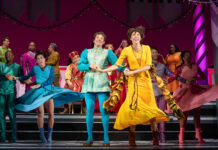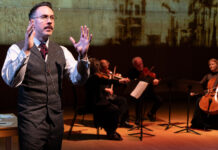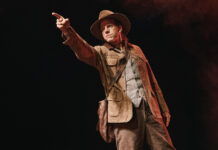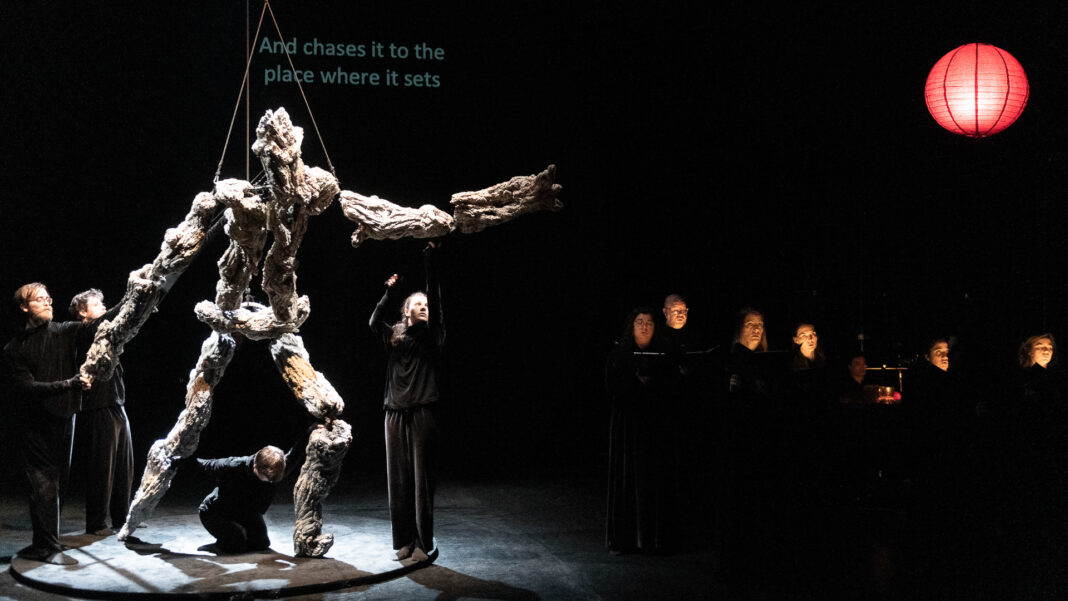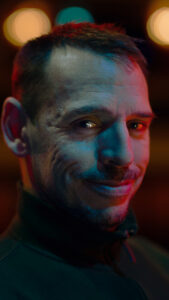
Basil Twist is the person you go to when you want puppets to help tell your story. Not traditional puppets, but often large-scale works that are abstract. You wouldn’t necessarily think of going to a puppet artist for productions of A Streetcar Named Desire or Petrushka or Symphonie Fantastique. Shows like The Addams Family Musical and the musical version of Charlie and the Chocolate Factory seem like more natural fits. Twist did them all.
He has now collaborated with composer Huang Ruo on Book of Mountains & Seas which is having its U.S. premiere at St. Ann’s Warehouse in Brooklyn in collaboration with Beth Morrison Projects. Twist is both director and designer for the work which had its world premiere last year in Copenhagen.
Book of Mountains & Seas is based on a revered book of Chinese mythology. Man’s relationship to the natural world is at the center of these stories.
Ruo has created a work for 12 singers and two percussionists that focuses on four main stories: Pan Gu, the Spirit Bird, Dragon King and Kuo Fu. Twist designed enormous puppets and other elements to help realize Ruo’s vision.
Earlier this month I spoke by Zoom with Twist who was in Montreal for a puppet festival. What follows are excerpts from that conversation that have been edited for length and clarity.
Let me start by asking if you still have a poster of the Disney animated film Peter Pan in your studio and do you see yourself in that character?
How did you know that? I still have a Peter Pan feeling, although I question it as I get older. I played Peter Pan in a Mabou Mines production years ago and it was a super important role and an awesome role to play in a puppet way. So that reinforced my Peter Pan-isms. But yeah, I do have that poster still. I’ve had the studio for almost 30 years and I’ve had that poster for almost as long.
What did you respond to in Book of Mountains & Seas?
The kind of epic-ness of each story, the hugeness of each of them. They’re each this massive creation myth. Half of each of them felt daunting, but also let’s see how to do this. The trick was also that the project was brought to me way before the music was finished. So I just had the stories and had to start imagining how to do that in a practical way. And a lot of what I do is taking sort of really outrageous ideas and embrace something that’s really challenging in the staging of it. How would you do the creation of the world?
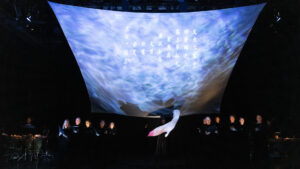
You have these four main stories and characters. Conceptually how did you address the challenge of staging it?
I try and create an overall world so there is a very specific esthetic world that all of the pieces fall into. It’s trying to find a common language that will work with all of those four stories. And that language is silk because I use silk a lot and silk is an extremely generous and transformative material. And then Chinese paper lanterns just because of the subject matter. Then the last element was driftwood. So there’s something light and formal, which is the lanterns. There is something completely fluid and mutable, which is the silk. There’s something that’s concrete that suggests the natural world and also a sense of time because driftwood has weathered. So breaking it down into these three elements. Then how do I tell these four stories just using those elements?
Using natural materials seems to fit, well, naturally, into a story that seems so concerned about man and the environment. How important is it to you that your work help get the message built into these stories across to audiences?
It’s important to set with this stories an appreciation of the natural world and a reverence for it. At least one of the details has a kind of apocalyptic potential to it. Even while enjoying extraordinary music and the beautiful visuals that we have, it is meant to to remind us of our place in this precious world we live in.
How extraordinary to have been working on it in Copenhagen and then I was spending a lot of time in California during the pandemic, kind of darting back and forth. To imagine being on opposite sides of this ball called planet earth, working on this show, was actually all the more resonant for me.
All mythology gets slightly altered as the stories as passed down from generation to generation. Is this iteration of Book of Mountains & Seas another alteration in the telling of these stories?
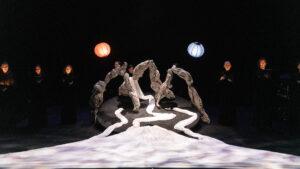
There must be, but it’s not just because it’s filtered through my form of storytelling. My staging is so spare and sort of minimalistic. I boil it down to some real essences, but I guess that’s just simply a matter of practicality or clarity in my storytelling. But as far as the stories themselves, I always tried to stay true to what Huang Ruo was sharing with me. His really wonderful passion and commitment for his family’s culture and these stories and the importance of them; I just wanted to respect that.
Since I started by asking you about Peter Pan, I’m going to end by asking you about something that J.M. Barrie wrote in The Little Minister: “The life of every man is a diary in which he means to write one story and writes another; and his humblest hour is when he compares the volume as it is with what he vowed to make it.” Looking back from this point in your life and career, how does the story you set out to write compare to the reality of the story it has become?
I just wanted to make things that honestly pleased me. That’s my measure: if it was interesting to me, what I thought was missing, what I wanted to see. So I started to make it mostly for myself. So to be in a place where the different opportunities that have come in response to that sort of staying true to myself, that’s allowed me to become a mentor to a lot of other people. I’m here in Montreal at a puppet festival where puppeteers are excited to meet me. It’s amazing to be in my fifties now and be someone who other puppeteers admirer and that I’ve influenced them. That’s at odds with the Peter Pan feeling that I still have inside, but that’s extraordinary. I didn’t set out for that.
Books of Mountains & Seas continues at St. Ann’s Warehouse through March 20th. For tickets and more information, please go here.
Main Photo: Books of Mountains & Seas (Photo by Teddy Wolff/Courtesy Beth Morrison Projects)


